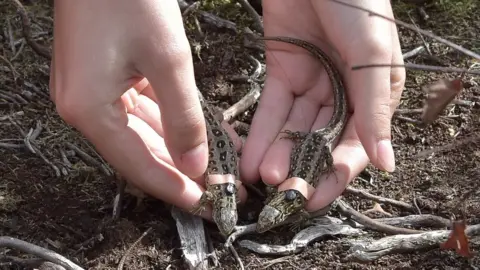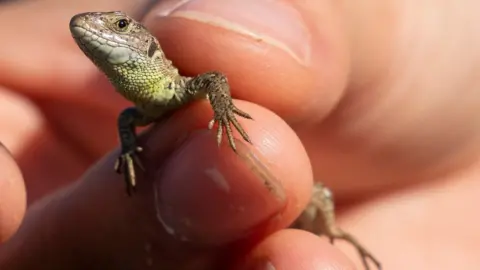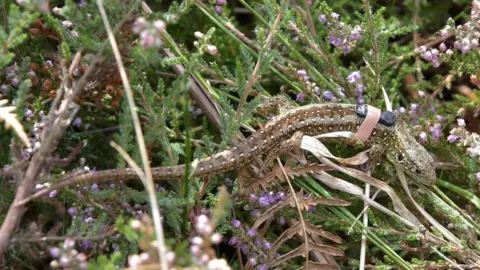Reintroduced sand lizards tagged with transmitters in Hampshire
 Paul Drane
Paul DraneRare sand lizards that have been reintroduced to the wild in Hampshire have been fitted with transmitters in a bid to understand more about them.
Conservation charity Marwell Wildlife has fitted radio tags to 24 out of 86 of the reptiles released at Eelmoor Marsh in Farnborough.
It is believed to be the first time radio tracking has been used to monitor reintroduced sand lizards in the UK.
Sand lizards are protected under the Wildlife & Countryside Act 1981.
 Paul Drane
Paul Drane Marwell Wildlife
Marwell WildlifeCapturing, disturbing, injuring and killing sand lizards is prohibited, as is damaging or destroying their breeding sites and resting places.
"The species disappeared from much of its former habitat in England and Wales due to habitat loss and degradation, but is recovering following concerted conservation efforts," Marwell Wildlife said.
Rachel Gardner, of the charity, said: "Because they blend into the environment and spend time foraging and hiding in dense undergrowth, sand lizards can be incredibly difficult to see.
"Being able to track them in this way is really exciting - I can't wait to see how far they go, how quickly, and exactly how they use the habitat."
 Paul Drane
Paul DraneShe added: "Having spent the last year rearing the lizards in captivity, it's wonderful to finally release them into their natural habitat and apply this novel technology to see how they do."
The tags, which weigh 0.29 grams (0.01 oz) - less than 5% of a sand lizard, fall off after a short time or when the lizard sheds its skin, Marwell Wildlife said.
Now in its second year, the project at Eelmoor Marsh Site of Special Scientific Interest (SSSI) will see a total of about 250 sand lizards released.

Sand lizard facts:
- They live on protected heathland sites in Surrey, Dorset, Hampshire and in the protected Merseyside dunes
- They grow up to 20cm (7.8in) long and weigh about 15g (0.5oz)
- Both sexes have brown patterns down their backs with two stripes
- Their diet is mainly insects, spiders and grasshoppers

